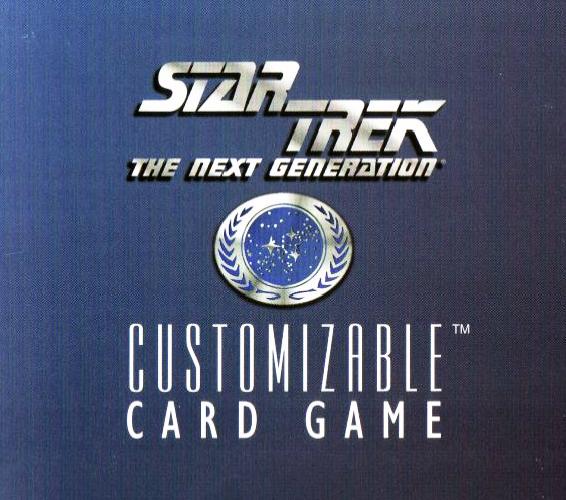
Growing up as a nerdy little kid, I played a lot of different collectible card games. In no particular order, I’ve dabbled in Magic, Pokemon, Raw Deal, Dragonball Z, MLB Showdown, Overpower, and surely others I am forgetting. Many games cycled in and out of my life without much more than a passing thought. But one game was different. Instead of passing through, it made a home. And for me, it became more than a game. It was a way of life. It was Star Trek CCG.
Decipher’s Star Trek CCG, as you have undoubtedly deduced, is based on the greater Star Trek series. Growing up, Star Trek: The Next Generation was my Star Trek. I knew about Kirk and the gang from the original series, but TNG was new and modern. It also, tragically, aired at 9pm. As a young child, I was rarely allowed to watch past the initial episode hook before being sent to bed. What crazy adventures would the Enterprise go on?! I could only imagine from my bedroom.
As the years went on and I grew older, I was finally able to catch afternoon reruns of TNG. Episode gaps were filled in and new adventures were discovered. I sank deeper into the Star Trek mythology. The world, the characters, the hi-jinks, it all very much appealed to me.
And then, at the height of my Star Trek allure, I was introduced to a new game…
Star Trek CCG – The Introduction
One fateful day, I was hanging out with my friend who was very much into Star Trek. His life made my fandom look amateur. He had Star Trek books and toys and episodes recorded on VHS. But my friend had something new to show me that day. He had just picked up a card game based on the series and was curious if I wanted to play. Of course I did!
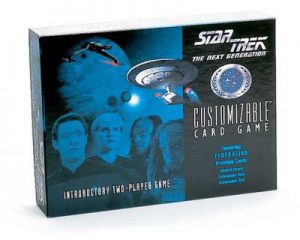
The game was called Star Trek CCG. Specifically, it was the Introductory Two-Player Game. Everything we needed to play was in front of us. One of us grabbed the Federation deck and the other the Klingons. We laid out the spaceline and he explained the rules. You had an outpost where you played your characters. They took ships to attempt missions. You could battle your opponent’s personnel. It was an episode of the television show come to life.
Basically, it was awesome.
After we finished the first game, I immediately wanted to play again. Unfortunately, there wasn’t any more time and I had to go home. Just like the beginning of a TNG episode, I was hooked and wanted more. Little did I know how much more was out there.
The Early Days
At this point in my life, I was only tangentially aware of the CCG concept. Star Trek was so much more than a one-and-done card game. There were entire sets and expansions collectible via booster packs. You could create your own decks using whatever cards you wanted. The options were endless.
Star Trek CCG was relatively new when I was first introduced, with just three full sets released (Premiere, Alternate Universe, and Q-Continuum). But for little ol’ me, even three sets was staggering. Where do I begin? Which packs have the best cards? It was overwhelming but also exciting. So much to discover!
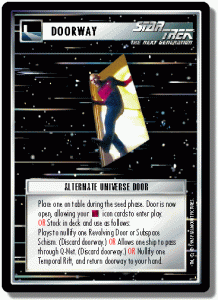
As a child, I was obviously dependent on my parents to buy booster packs. Adding cards to my collection was a rare treat and I had to choose wisely. Premiere was an obvious choice, but when possible, I experimented some with the expansions. Alternate Universe was always especially exciting because any pack could have the Ultra-Rare Future Enterprise (although I never found it). Q-Continuum mostly just confused me. The cards had weird icons and I didn’t know their special rules. But I was never short on free Warp Pack cards like ‘Yellow Alert’ or ‘Countermanda’.
One of my favorite memories is going to the local hobby store with my friend and buying a few packs of Premiere. My friend’s sole purpose in life was to pull a ‘Geordi La Forge’. It’s all he talked about. It was almost annoying. He opened his pack and fanned through it card by card. He came across a new Klingon card and, not knowing much about rarities, assumed that was the rare in the pack. Then BAM, as if it was an act of God, Geordi La Forge appeared. My friend screamed like a little girl. People in the store stared, but he didn’t care. Geordi was finally his.
***
Over time, I began to cobble together a meager collection. My decks were mostly just modified versions of starter decks, but I didn’t care. I was addicted. Not only was the game fun but I learned more about Star Trek than I ever had from watching the show. I was all in.
But I wasn’t the only one. All my friends loved it too, which just spurred the hobby further. My best friends and I couldn’t talk about anything but Star Trek. Can’t you picture how nerdy we were? Deck strategies were discussed and cards were traded. We would play games late into the night cross-legged on the floor. It was all Star Trek all the time.
Had it just been a simple game I played from time to time, it wouldn’t have made much of an impact. My amazing group of friends is what ultimately sucked me in. The group of like-minded friends turned Star Trek from a game into something more. And it was just getting started.
The Expansion – First Contact
A year after Q-Continuum, only a few boutique products had been released. This was fine by me, as it gave me time to collect and play. The current state of the game was all I knew and I loved it. But there were rumblings of a new expansion on the horizon. Finally, in December of 1997, the First Contact expansion hit the market and changed the game forever.
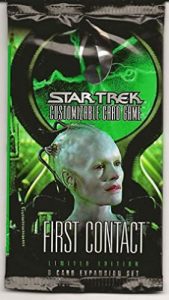
First Contact was big for so many reasons. The first was that it expanded the game to include even more Star Trek. Decipher’s Star Trek rights originally encompassed only the TNG TV show. Now it included everything. First Contact was the first step into the entire world of Star Trek.
Secondly, the expansion revolutionized the rules of the game. The first new affiliation was added, the Borg, which turned the game upside down with bizarre and often dense rules. But it wasn’t just an addition of a new affiliation that altered the game. There were new card types, a new way to construct your deck, and new personas of existing characters. It radically altered the game in the best way possible.
Most importantly though, First Contact was the first new expansion published since my friend group began playing. The anticipation was palpable. I remember the first time I saw the new cards on the store shelves. They didn’t look like any other packs that had been released. Pack art up to this point was simplistic. First Contact packs had the friggin’ Borg Queen!
I begged my parents to buy me a few packs, even just one! The first pack I opened had something incredibly underwhelming like Paul Porter. But every card was new and exciting. I remember how envious I was when my friend’s grandma purchased him 20 packs. 20 packs?! Are they made of money? Come on!
The expansion also brought in more players and organized events. Our local comic book store started hosting Star Trek CCG game nights and tournaments. It was no longer just our group of friends, but a whole world of players. It was as if everything we had done up to this point was prologue. First Contact kicked off a new era of Star Trek CCG.
The Golden Age
During the next few years, a multitude of exciting expansions were released. Deep Space Nine introduced a whole new series to the game including the Bajoran and Cardassian affiliations. The corresponding TV show was in its prime and the characters were a welcome addition. The next couple sets doubled down on DS9 with The Dominion and Blaze of Glory. The game was truly hitting its stride.
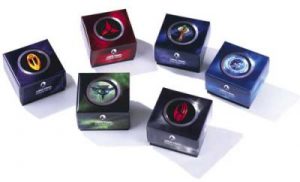
For my group of friends, Star Trek CCG was nearly omnipresent. We gathered wherever we could. Sometimes it was at the local gaming store. Other times it was at our houses on the floor. If we were being sneaky, it would be at school. We would test out new decks the night before a tournament. Or sometimes we constructed some crazy circular spaceline with 6 different players. It could get chaotic but it was always memorable.
Because we were still young and poor, we all had fairly limited collections. To combat this, most everyone fell into a niche. I focused on Federation. Another friend on Romulans. Yet another on Klingons. Among the group, we had pretty much every affiliation covered (except maybe Bajorans, because they weren’t that exciting). While we were certainly protective of our cards, we knew who our first trade target would be when we pulled a Rare we would never use.
During this time some great boutique products were released, most notably the Official Tournament Sealed Deck. To this day, it is probably my favorite Star Trek CCG product released. It gave you everything you needed to create a deck (including booster packs) and came in an affiliation themed box. What wasn’t there to love? I remember a group of us were able to each pick up a box and have an informal OTSD tournament. We played, of course, on my friend’s floor.
Competitive Play
As the game matured, so too did the competitive scene. It wasn’t long before our hometown area began holding Regional tournaments. These were official qualifiers for the next round of World Championship tournaments. They brought out the best players with the best decks and were not to be missed.
I was always a middle of the road player myself. I rarely won any tournaments, but I usually wasn’t at the bottom either. One reason I didn’t win much was because I had a friend that WAS really good at the game. He would come up with the craziest decks that people never expected and then just dominate. If you had any chance of winning a tournament, you had to beat my friend’s carnival of horrors first.
It was fun to root for my friend during various Regionals because he actually had a shot. I don’t remember if he ever outright won a Regional event, but at the very least he got Top 2 on a few occasions which qualified him for the next tournament. He was certainly the best of us.
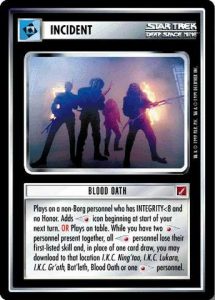
For me, Regional tournaments were exciting because you got to see new and high powered decks, even if they were creaming you. Powerful and sometimes broken decks were only rumors until they were across the table from you. Seeing them in person was worth the price of admission.
But there was one Regional tournament where I got close to sweet sweet victory. I used a Klingon deck, which was odd for me. You’ll remember I was normally a Federation player, so I don’t know what inspired me to switch at such an important event. But somehow I stumbled upon an ‘Assign Mission Specialist’/’Blood Oath’ combination that often let me complete 2 missions to win.
Using the deck, I was undefeated after 4 rounds of a 6 round tournament. It was easily the best I’d ever done at a big event. Other players, some I hardly knew, were already saying I had a good shot at winning. It was unreal.
Then during my next game all of my missions got sucked into a ‘Black Hole’. That’s Star Trek for you. I had no way to combat such a deck and easily lost. For the final game, I was matched up against one of my friends. We were both 4-1 at this point. His deck was eerily similar to mine in terms of mission selection, except he was playing Federation. It was a close game, but he was able to solve our shared missions faster than I. He won, going 5-1 and I fell to 4-2, good for fourth place overall.
While I was disappointed I lost my final two games, I was still overjoyed to have taken fourth place in such a big tournament. Even better, 3 of the top 4 spots were players from our friend group. It was a great showcase of our skills and how far we had come.
Home Brewing the Game
As great as official tournament play was, sometimes we just wanted to break the rules and have fun. My friends and I would come up with some home brew formats like battle-only rules or bizarre spaceline setups. The game was so expansive and flexible we could basically recreate episodes in the series or make up our own adventures. It allowed our creativity to flow.
Special rules for a Dominion War games were made. Or games where you could use any personnel in your deck without Treaties. There were games where you had to fight off the Borg or battle a hundred Romulan D’deridex ships. The options were endless.
At one point there was a big effort between local players to establish a massive multiplayer format. After much testing and multiple drafts, a byzantine rulebook was created. 8-10 players lined up on opposite sides of a massive table and constructed one giant spaceline. Every player represented a different affiliation. It ended up being a complete mess and dreadfully boring but for some reason I look back fondly on it.
All Good Things
The Rules of Acquisition and The Trouble with Tribbles expansions were released in 2000. For our playgroup the game was still going strong. Cracks in the game itself began to appear, but it wasn’t something I was concerned with. I was having as much fun as ever.
Then my family moved half way across the country. And because I was in ninth grade, they made me come with. How dare they?!

Just like that, I was torn away from my friends and the game I loved. Boxes and boxes of cards with no one to play with. It was tough. As much as I enjoyed sitting alone constructing decks, the true joy was playing with my friends. It was a huge part of my life that was simply taken away.
My family moved to a city with a thriving Star Trek CCG scene. Curious, I played in a local tournament, but something just didn’t feel right. There were tons of people. I won a cool “case-topper” card in a raffle. When it was over, as always, I placed right in the middle. But all in all, it felt very lonely. Between games I sat around, examining my cards, talking to no one. I wasn’t outgoing enough to make new friends, but I also didn’t really want to make new friends. I already had friends, they were just far away.
From there, my Star Trek CCG cards mostly collected dust. I still followed the game, but didn’t buy new cards. The game itself began to go downhill. The rules were bloated and decks focused on overpowered Delta Quadrant affiliations. Many of my friends stopped playing. The game was dying.
Sure, there were some rare times I was able to visit my friends and bust out an old deck, but it quickly became nostalgia more than anything. For all intents and purposes the game was over for me.
Or Was It? – Second Edition
Star Trek CCG continued on as a full game for another 3 years until it finally ceased. But Decipher had a plan to reinvigorate the game. Before it’s discontinuation, Decipher released Star Trek CCG: Second Edition. It was a revamped version of the original with a new cost mechanism and streamlined gameplay. It attempted to cut down on the bloated rules and create a balanced game.
And everyone hated it.
Hardcore players of the original game (1E) felt betrayed. Decipher basically made their entire collection worthless. Yes, the company said they would still support the game through backwards compatible cards, but everyone could see that Second Edition (2E) was the future.
Unfortunately, the 2E game paled in comparison to the 1E game. 1E was a deeply rich game that had been around for over 8 years. Sure, it had problems, but the players loved it. 2E was a brand new game with little depth and comparatively boring gameplay. It was a bitter pill to swallow.
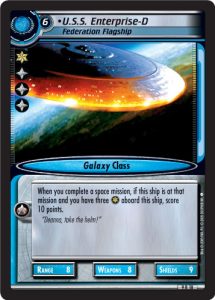
By this time, I was approaching college and Star Trek CCG was mostly a childhood memory. I followed some of the news and the response to 2E, but I had no desire to try out this new version of the game. It was universally disliked by my friends who tried it and none of my existing cards would be playable. Oh well.
More time passed and 2E continued to grow. The game had its struggles, but a loyal player base existed. I continued to follow the game closer and closer, becoming intrigued. Decipher offered free printable demo decks, so I tried out the game. It was different from 1E, but had a lot of similar qualities. It didn’t feel like an episode of Star Trek, but the rules made a lot more sense.
2E piqued my interest enough to investigate further. I discovered that there was an active playgroup close to me. Not only that, they were having a Dangerous Missions draft. It would be a perfect way to test the waters. So I entered the tournament. I pretty much got dead last, but still had fun. It was different from 1E, but not different in a bad way. I was officially sucked back in.
The Final Decipher Years – What You Leave Behind
I started from scratch in 2E but quickly built up a collection. Other than Necessary Evil, 2E cards were relatively cheap to come by. I was also pretty much an adult with a job and all that, so I could afford to spend money on hobbies without begging my parents. It was a dangerous combination. It wasn’t long until I was opening up box after box (or case) of 2E cards.
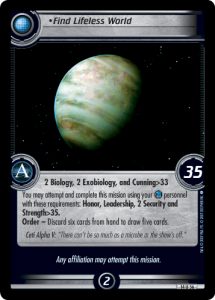
Four full 2E sets (and one boutique product) were released in just over a year after I began playing. It was a crazy time to join the game. New factions like Voyager and TOS were being added and the game was truly maturing. Long gone was the original 2E that many players spurned. A new 2E had formed with a variety of flavors and mechanics to explore. It would never have the depth of 1E, but 2E found a nice balance that 1E lacked.
Soon I became competitive in tournaments. My familiarity with 1E helped tremendously and the more streamlined rules were easier to dissect. Whereas I was always a mediocre 1E player, years of experience (and money) made me an upper tier 2E player in the region. I even constructed a broken deck that got a card errata’d, which always makes a player feel accomplished.
Unfortunately, Decipher was facing hard times. Their games, while still popular, were becoming more niche than mainstream. A series of new game launches went poorly. An infamous embezzlement left Decipher strapped for cash. Decipher was either unable or unwilling to renew their Star Trek license. Only a year after I started playing 2E, the game was about to die.
Or Was It? – The Continuing Committee
Upon realizing the impending death of Star Trek CCG, a group of players took up the charge to continue the game. Much like after the demise of Star Wars CCG, a new volunteer organization was formed that would support the game in the absence of Decipher. The group was called the Continuing Committee, named after a Romulan governing body (with obvious double meaning). Thankfully, nearly everyone who worked on the game with Decipher transitioned to this new group.
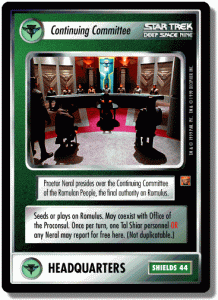
Our local base remained strong, having cautious optimism regarding the Continuing Committee’s efforts. Some of the first releases and initiative were bumpy, but it was better than no Star Trek at all. We were more than happy to continue our monthly meetups. And hey, now all of the new cards were free. We just had to print them.
I began to take on a larger role within the local scene by holding tournaments of my own. To me, 2E was still an exciting experience. After not playing any Star Trek CCG for over 6 years, I had a fresh bout of enthusiasm for the game.
The same couldn’t be said for everyone else. What was once a strong 2E base slowly began to dwindle. Some players grew tired of playing a dead game. Others were underwhelmed by the Continuing Committee’s efforts. And some people simply moved on. Within a year or two, we were struggling to get 4 players for a sanctioned tournament.
And I must admit that soon my enthusiasm for the game began to wane as well. I enjoyed playing, but instead of spending weeks testing out new ideas, I found myself grabbing old decks before tournaments. I was now in grad school, the game was on the downhill, and it just wasn’t holding my interest.
1E was torn away from me, but I left 2E on my own terms. There were great times with great people. I even enjoyed briefly being the top player in my region. But it never really lived up to my experiences with 1E nor did I ever expect it to. 1E was an experience whereas 2E was a game. I eventually reached a point where I was simply done playing.
Epilogue
Star Trek CCG played such an important role in my life. It wasn’t always at the forefront, but it was always lurking in the background. The game was the original impetus of many friendships, some which last to this day. It sent me on trips and kept me up all night with friends. It captured a perfect storm of nerdiness.
It’s funny to think how important a game is to me. I mean, it’s just a bunch of cardboard with pictures from Star Trek. But Star Trek CCG was more than just a game. It was a puzzle, a hobby, a social experience. For many years, Star Trek CCG was a way of life. But most importantly, it was friendship.
Wonderful article. Brought back many memories. I am addicted to building 1E decks to this day. I would assume you and I are around the same age. I have since taught my son how to play it. Hell, I bought 2 booster boxes online today. This provided me with a trip back in time to my increasingly distant youth. It was a great time to grow up wasn’t it?
Yes, to this day I look back on the age fondly. In many ways, STCCG had a great impact on my life. I’ve tried to get into some other modern card games, but nothing recaptures the magic of STCCG. As you said, I think it was as much the time of life as it was the game being played, which is impossible to recreate now. Glad to hear you are passing it on!
Thank you for sharing your story. I didn’t have a group of friends who regularly played 1E, but I experienced so much joy collecting it and developed a solitaire form of the game that kept me entertained. What I liked most about it was, as you said, it felt like you were playing an episode of Star Trek. So many CCGs just felt like games with licensed picture. This was an experience. And it’s also why I never got into 2E. I was surprised today when I looked on eBay and saw that lots of approx. 1,000 1E cards are selling for like $20. I thought about selling my large collection to make some space, but it looks like I may end up paying to ship them. A good excuse to hold on to them, I guess. lol
Your story is eerily similar to my older brothers! Thank you for sharing. I do have a question, where can I look at lists of old deck postings and deck strategies pre Continuing Committee? I still create a lot of decks myself and would be curious to see what others came up with. Thanks again.